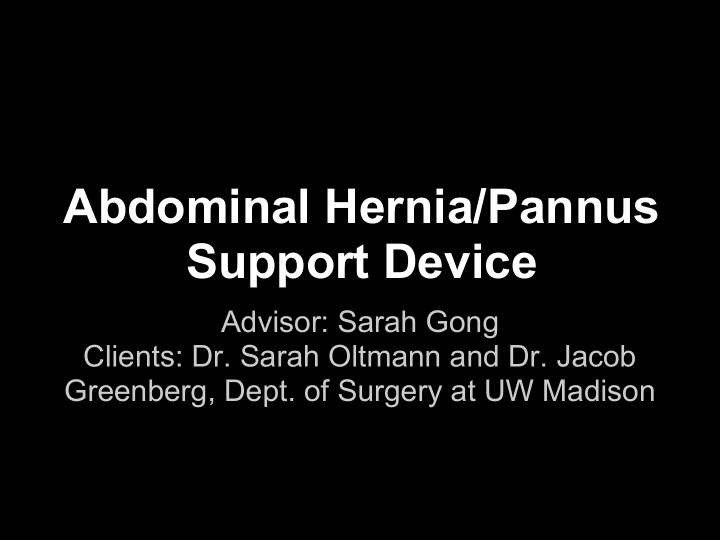



Abdominal Hernia/Pannus Support Device Advisor: Sarah Gong Clients: Dr. Sarah Oltmann and Dr. Jacob Greenberg, Dept. of Surgery at UW Madison
Project Introduction Prospective Consumers: ● Patients with large abdominal hernias ● Obese patients with large pannus Current Health Issues: ● Sensitive skin/scarring ● Heavy tissue mass/no support ● Lack of circulation ● Back problems/muscle strain
Patient Before/After Abdominal Hernia Repair Surgery http://design42.blogspot.com
Background of Hernia/Pannus Support Device Current Solutions: ● Maternity brace ● Abdominal binders Existing Ineffective Designs: ● Do not fit all body types ● Lack lifting force ● Tighten around sensitive skin ● Difficult to clean/use
Past Ineffective Current Support Designs Devices https://www.strutpatent.com
Problem Statement Develop a prosthetic that will ● Provide a lifting support ○ Pannus ○ Hernia Sac ○ 5-100 lbs ● Materials ○ Washable ○ Breathable ○ Skin-friendly ○ Durable ● Adaptable for market production
Specifications ● Prototype is specific for Dr. Greenberg's patient ● Awaiting measurements ○ Shoulder width ○ Shoulder to hip ○ Pannus/hernia maximum circumference ○ Waist circumference under pannus/hernia ○ Length of pannus/hernia ○ Width of back ○ Weight ○ Height
Design Components ● Straps over shoulder ● Support belt ● Lifting of hernia/pannus ● Side abdominal support Side View Drawn by Cody Williams
Materials - Rubber Band ● Would create lifting force ● More bands, more distribution ● Different bands for different lifts ● Could incorporate into material ● Foreseen difficulties putting on ● Not breathable Front Back Drawn by Cody Williams
Materials - Elastic Fabric ● Very customizable, easy to work with ● Breathable ● Washable as is ● Basis of current devices ● Not much lifting force ● Stretch over time
Materials - Rigid Fabric - Allows transfer of forces - Little to no stretch - Durable - Breathable - Needs alternate lifting force
Materials Design Matrix Criteria Rubber Band Elastic Fabric Rigid Fabric Effectiveness (30) 25 15 22 Safety(20) 10 17 17 Comfort(15) 5 13 13 6 13 13 Maintenance(15) Ease of Use (15) 6 10 13 Cost Effectiveness (5) 1 3 3 Total (100) 53 71 81
Fastening - Buckle ● Affordable ● Easy to use ● Easy to conceal http://www.plasticimpex.com ● Ineffective at maintaining support ● Easily breakable
Fastening - Ratchet ● Effective at maintaining support ● Safe ● Durable ● Heavier http://www.cargoequipmentcorp.c
Fastening - Winding ● Easily concealable ● Easy to use ● Ineffective at maintaining support ● Difficult to acquire http://www.google.com/patents/US201103037
Fastening Mechanisms Design Matrix Criteria Buckle Ratchet Winding Effectiveness (30) 15 28 22 Safety(20) 10 17 14 Concealability (15) 13 8 13 13 13 4 Maintenance(15) Ease of Use (15) 13 12 12 Cost Effectiveness 4 5 2 (5) Total (100) 68 83 67
Proposed Design Upon further consideration multiple aspects were chosen: ○ Rigid fabric for the support below the hernia, the belt, and suspenders ○ Elastic fabrics for the hernia containment Created by Cody Williams
Proposed Design Upon further consideration multiple aspects Ingeo were chosen: ○ Ratchets for fastening the various straps ○ Shoulder straps distribute load ○ Put belt on below hernia and lift up Created by Cody Williams
Conclusions The proposed design should provide optimal lifting support and weight distribution. Comfort and ease of use should make it realistic for everyday use until surgery. Once the materials are finalized, ready to begin prototype development.
Future Work ● Obtain measurements from Dr. Greenberg ● Prototype proposed design ● Safety testing ● Request clients' approval ● Have Dr. Greenberg deliver device to patient and obtain feedback ● Alter prototype to patient's requests ● Finalize product ● Patent?
References 1. http://design42.blogspot.com 2. http://www.strutpatent.com 3. http://www.plasticimpex.com 4. http://www.cargoequipmentcorp.co 5. http://www.google.com/patents/US20110303782
Recommend
More recommend